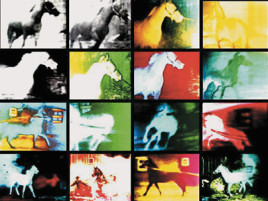Transcript
The music video: “What had been a liberating possibility for visual artists working in film, to bring their work towards a wider audience, without the pressure of narrative, without the necessity to tell stories, has become an absolutely fixed promo for the consumerism aimed at the youth market”.
So says Professor Rod Stoneman in this, the third in Pod Academy’s series based on his book, Seeing is Believing: the Politics of the Visual. which is produced and presented by Esther Gaytan Fuertes.
In this podcast, Rod Stoneman talks about the visual experimentation made possible by the music video, which pushes the boundaries of mainstream narrative film.
You can find other podcasts in the series here: Podcast 1 on Fashion images and Podcast 2 on graffiti
Rod Stoneman: This image [above] comes from a film called Berlin Horse made by Malcolm Le Grice in 1970, an experimental film from the London Filmmakers’ Co-op. And it’s a striking visual image made from permutations of colour printing, using loops, a horse going round in a circle and a clip from an early American silent film, working alongside music in an interesting way. The music is created by Brian Eno using loops of guitar chords, which the chords are of different lengths so as they go round they change the relationship of the different sets of guitar chords to one another. And it suggests a previous history of work with sound and image happening in the experimental domain: Kenneth Anger made Scorpio Rising and Kustom Kar Kommandos even within I’d say mainstream films but even within feature film productions like Performance by Nicholas Roeg and Donald Cammell there is a sequence where Mike Jagger comes out of character to create a music video, you could say, or premonition of, and Bob Dylan’s famous film with the different lines from Subterranean Homesick Blues.
These are precursors of something that really developed when music television started in the early 70s, when MTV was created. Gary Kemp from Spandau Ballet was absolutely right when he said, video was something that a band had to be good at; if you weren’t visual, if you couldn’t work in front of a camera you were not going to happen as a band.
It’s absolutely clear that, at that moment, MTV offered a possibility for brave and experimental work which didn’t have to be concerned with story telling or narrative to connect with contemporary music and reach a wider audience. But, quite quickly industrial constraints exerted themselves and some videos were taken to be too difficult or too experimental or —occasionally the phrase was used— not ‘MTV- friendly’. That excluded some work, also contracts to be drawn up —I mean, a pop-promo is precisely a promotional tour— and contracts began to be drawn up defining what the film-maker had to achieve in terms of, say, featuring a medium close shot of the lead singer of the band within the first 30 seconds.
So that began to close what had been a liberating possibility for visual artists working in film, to bring their work towards a wider audience, without the pressure of narrative, without the necessity to tell stories. The current version of music videos is an absolutely fixed promo for the consumerism, aimed at the youth market. MTV itself has moved off to other formats, to reality television, and the space for something as extraordinary as Malcolm Le Grice’s Berlin Horse —which, interestingly, was used in the Doves’ music video Catch the Sun in a rather decorative way— the space for new visually experiment has really been closed off.
If you have enjoyed this podcast, remember you can listen or download the rest of this series from our website, www.podacademy.org
Seeing is Believing: The politics of the visual is published by Black Dog (UK £19.95, US £29.95) It explores the complex and reciprocal dynamic between world and image in this most visually mediated society. Everyone ‘knows’ images can be false or deceptive, but we all live and work in constant denial of this idea and its implications. In a world saturatedwith media we act as though we are immune to their effects.Structured in six parts “History/Politics”; “Art/Culture”; “Film/Television”; “Products/Possessions”; “The Quotidian/The Strange”; “Verisimilitude/Delusion”—the book analyses clusters of images to explore differentiated themes of pictorial operation including photography, graffiti, painting, film and television. Seeing is Believing is an invitation to an intimate voyage that is permeable to the world’s upheavals, exploring the potential for contemporary forms of artistic practice to create new spaces for active participation in culture and society.
Tags: Cultural studies, Media studies, Music videos, Politics of the visual


Subscribe with…